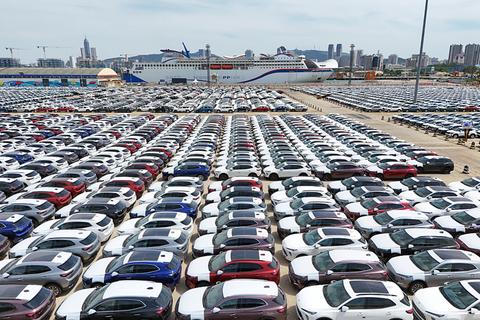
Read More《新车全打7折卖,这0公里二手车为啥这么香?》
Positive Comments: The “Win – Win” Appearance and Market Regulatory Value of Zero – Kilometer Used Cars
The recently hot – debated phenomenon of “zero – kilometer used cars” seems, on the surface, to be a special product under the price war and inventory pressure in the automotive industry. However, it also reflects the positive significance of the market’s spontaneous regulation. From the perspectives of consumers, dealers, and car manufacturers, this model has indeed created a short – term “win – win” situation at a specific stage.
First of all, for consumers, zero – kilometer used cars offer a cost – effective car – buying option. As mentioned in the news, a new car originally priced at 99,800 yuan can be purchased for just over 60,000 yuan through this channel. Popular models in the 200,000 – yuan range can be 10,000 yuan cheaper than those in 4S stores, and the prices of unpopular models are even lower. The price advantage of these “nearly new cars” is extremely attractive to consumers with limited budgets. Especially in the new energy vehicle field, the impact of the lack of first – sale benefits (such as on – board chargers and tire inflators) for some models is relatively controllable. Short – term users can still enjoy the experience of a new car at a lower cost.
Secondly, for dealers and car manufacturers, zero – kilometer used cars are an effective means to relieve inventory pressure. Under the traditional 4S store model, the mechanism where car manufacturers obtain rebates by pressing dealers to take inventory and setting high sales targets has long existed. In the current context where the auto market is shifting from a “seller’s market” to a “buyer’s market”, the inventory pressure on dealers has increased sharply. Zero – kilometer used cars, in the form of “including license and tax”, transfer the vehicles that have not met the sales targets to second – tier channels in the name of used cars. This not only helps 4S stores meet the manufacturer’s assessment and obtain rebates but also avoids the impact of direct price cuts on the new – car price system. Some new energy manufacturers even actively deliver cars to second – tier channels, expand sales channels, improve sales data, and enhance their say in the supply chain. This is of practical significance for stabilizing the short – term performance of car manufacturers and reporting to shareholders.
Thirdly, used – car dealers are the direct beneficiaries of this model. Compared with the uncertainty of “one car, one condition” in traditional used cars, zero – kilometer used cars have better quality assurance due to their “zero – kilometer” attribute. They also have a short turnover cycle and low customer – complaint risk, making them “high – quality products” in the eyes of used – car dealers. The used – car dealer Xiao C mentioned in the news believes that this is “an innovation in the automotive sales model in the Internet era”, and the interests of car manufacturers, car dealers, and consumers have been balanced in the short term.
From the perspective of the market mechanism, the rise of zero – kilometer used cars is also a natural reaction to the intensifying industry competition. When the traditional sales channels cannot digest the production capacity, the market will spontaneously find new circulation paths. The existence of this “gray area” objectively accelerates the inventory turnover, avoids the risk of capital – chain breakage caused by inventory backlogs, and has a certain positive effect on maintaining the short – term stability of the industry.
Negative Comments: The “Lose – Lose” Hidden Dangers and Industry Ecosystem Damage of Zero – Kilometer Used Cars
Although zero – kilometer used cars present a “win – win” appearance in the short term, their long – term hidden dangers have gradually emerged and may even trigger systematic risks in the industry ecosystem. The negative impacts of this model are fermenting in multiple dimensions, from consumer rights and interests, the authenticity of market data, the health of the supply chain to the overseas market reputation.
First of all, the damage to consumer rights is the most direct pain point. The news clearly states that zero – kilometer used cars cannot enjoy the first – sale benefits because they have been registered and transferred. For new energy vehicle users, this means losing key guarantees such as the lifetime warranty for the three – electric systems (the national standard is only 8 years or 160,000 kilometers) and on – board accessories. For example, when a user’s tire bursts, they may be in trouble due to the lack of tire repair fluid and a tire inflator. If the vehicle is held for more than 8 years, the maintenance cost of the three – electric systems (such as a 400,000 – yuan battery pack for the Polestar 2) will become a heavy burden. This kind of “trading low price for rights and interests” essentially means that consumers are paying for the industry’s chaos.
Secondly, the distortion of sales data undermines the fairness of the market and the reference value for decision – making. Since zero – kilometer used cars are included in the sales statistics after being registered, the sales data of car manufacturers are inflated. This “false prosperity” will mislead consumers (such as those who choose Nezha cars based on the sales list and end up suffering losses), investors, and industry observers, and exacerbate the short – sighted tendency of “only focusing on sales volume”. More seriously, the inflated sales data may cover up the real market competitiveness problems of car manufacturers, delay the improvement of product power and brand power, and ultimately lead to the “bad money driving out the good”.
Thirdly, the supply – chain risks are further magnified, which may trigger a chain – reaction collapse in the industry. The proliferation of zero – kilometer used cars is essentially an extension of the price war. Car manufacturers have to continuously reduce prices to maintain sales, and the cost pressure is ultimately transferred to the supply chain. As mentioned in the news, suppliers are facing capital problems such as a long “6 + X” payment cycle and acceptance bills, and at the same time, they need to meet the unreasonable requirements of car manufacturers for “cost reduction every year”. As a result, some enterprises reduce costs by reducing the configuration (such as reducing the leather thickness, applying less top – coat paint, and using fewer screws), and even “sacrificing safety for cost”. If dealers face liquidity risks due to excessive price cuts of zero – kilometer used cars, suppliers may experience a chain – reaction supply interruption due to the arrears of multiple car manufacturers, which will eventually evolve into an industry crisis similar to the “Evergrande in the auto circle”.
Finally, the damage to the overseas market reputation affects the globalization process of Chinese cars. As mentioned in the news, zero – kilometer used cars are exported in large quantities due to their low prices (for example, the official price of the BYD Han in the UAE is 392,000 yuan, while the used – car price is only 220,000 yuan). However, due to the lack of warranty and unstable quality, they have damaged the high – end image of Chinese cars overseas. This kind of “self – destructive” behavior may repeat the mistake of “Chinese motorcycles in Vietnam”. Back then, Chinese motorcycles were finally squeezed out of the market by Japanese brands due to low – price vicious competition. If the chaos of zero – kilometer used cars continues, the hard – won “high – cost – performance + technological upgrading” advantage of Chinese cars in going global will be wasted.
Suggestions for Entrepreneurs: Uphold Long – Term Value in the Industry Chaos
The phenomenon of zero – kilometer used cars is essentially a microcosm of the “involution” in the automotive industry. For entrepreneurs, they need to avoid risks and seize opportunities from the following aspects:
- Respect the compliance red line and avoid short – term speculation: Some entrepreneurs may be tempted by the high profits of “zero – kilometer used cars” and participate in non – regular channel transactions. However, it should be clear that such models rely on the gray areas of the industry, and the policy risks (such as the possible regulatory measures to be introduced by the Ministry of Commerce) and the risks of consumer rights disputes are extremely high. Entrepreneurs should focus on compliant businesses, such as exploring value – added services such as used – car testing and warranty, rather than relying on “finding loopholes” to make profits.
- Pay attention to consumer rights and build a trust barrier: The core contradiction of zero – kilometer used cars is the conflict between “low price” and “lack of rights and interests”. If entrepreneurs are engaged in the automotive circulation or service field, they need to focus on consumers. For example, they can launch a “nearly new car warranty plan” and a “first – sale benefit compensation plan”, and establish user trust through transparent and standardized services, rather than simply relying on price competition.
- Be vigilant against supply – chain risks and strengthen cooperation resilience: For entrepreneurs in the upstream and downstream of the automotive industry chain (such as parts suppliers and new energy technology service providers), they need to be vigilant against the problems of excessive price cuts and long payment cycles by car manufacturers. It is recommended to clarify the payment cycle and quality standards through contract terms to avoid sacrificing the safety bottom – line for cost reduction. At the same time, they should expand diversified customers, reduce their dependence on a single car manufacturer, and enhance their risk – resistance ability.
- Focus on long – term brand building and resist vicious competition: Whether they are new car – making forces or used – car dealers, they need to get out of the trap of “only focusing on sales volume”. Entrepreneurs should invest resources in product power (such as three – electric technology and intelligent driving), service experience (such as user – community operation), and brand premium (such as high – end positioning), rather than relying on “data falsification” or “low – price dumping” to achieve short – term growth. For example, they can learn from BYD’s strategy of “technology first” and build long – term competitiveness with core technologies (such as blade batteries).
- Participate in industry co – construction and promote the improvement of rules: Facing the industry chaos such as zero – kilometer used cars, entrepreneurs can voice their opinions through industry associations, policy consultations, etc., and promote the establishment of more transparent circulation rules (such as clarifying the definition of “zero – kilometer used cars” and limiting the proportion of non – regular channels), a fairer supply – chain cooperation mechanism (such as standardizing the payment cycle and cost – reduction requirements), and stricter overseas market supervision (such as banning low – price dumping that damages the brand image).
In short, the phenomenon of zero – kilometer used cars is the “growing pain” in the industry transformation period. Entrepreneurs need to make a clear choice between short – term interests and long – term value. Only by adhering to compliance, focusing on users, and strengthening resilience can they stand out in the industry reshuffle.




